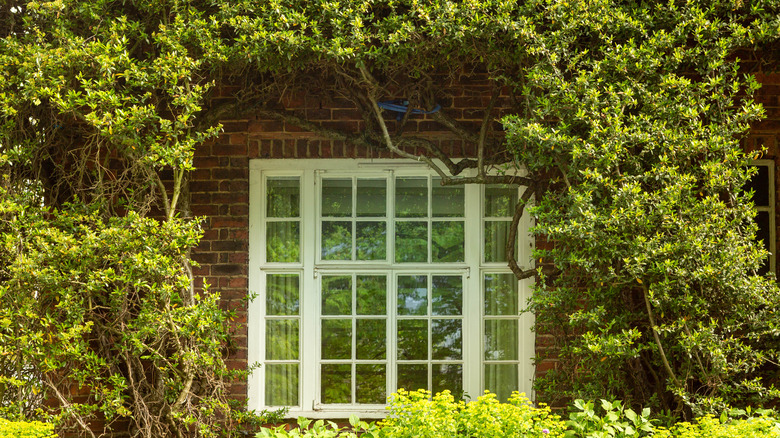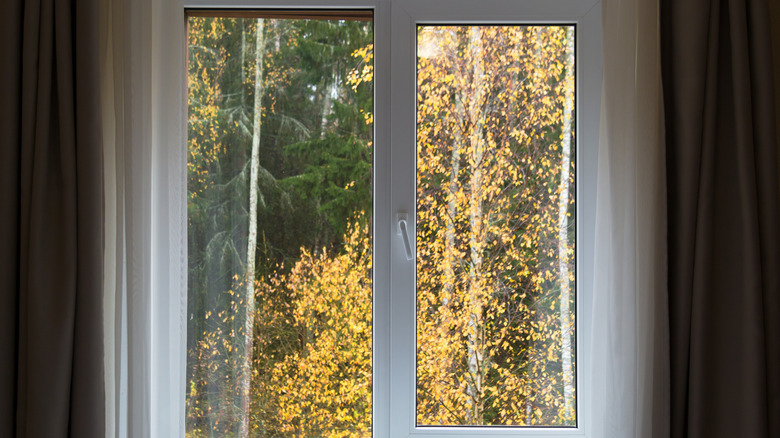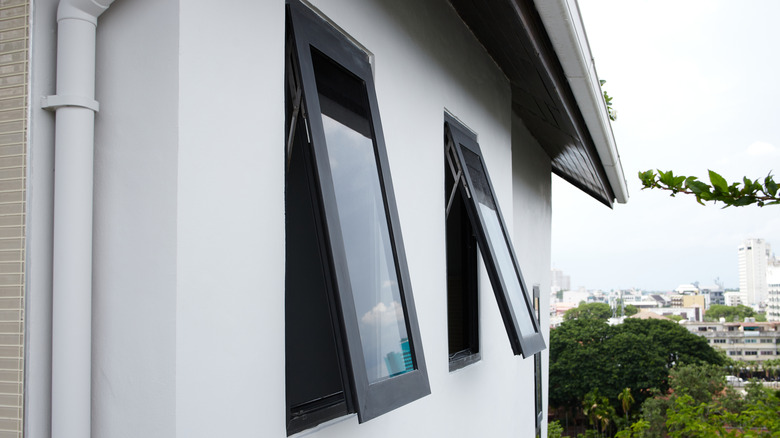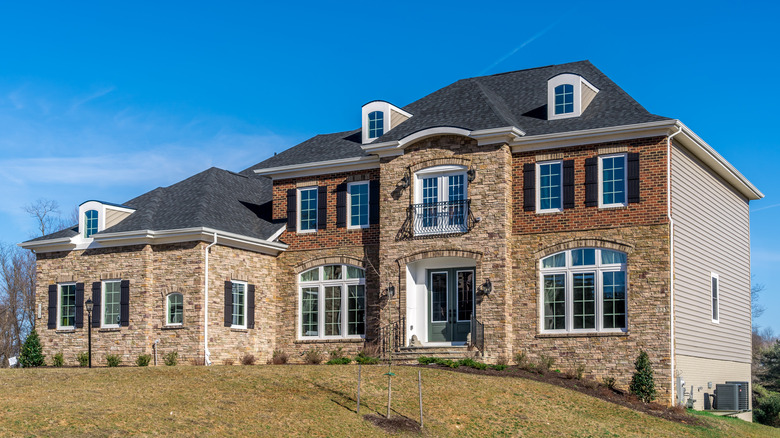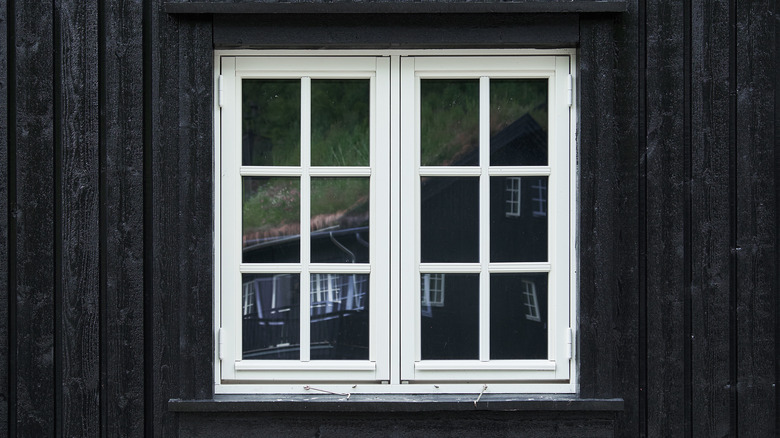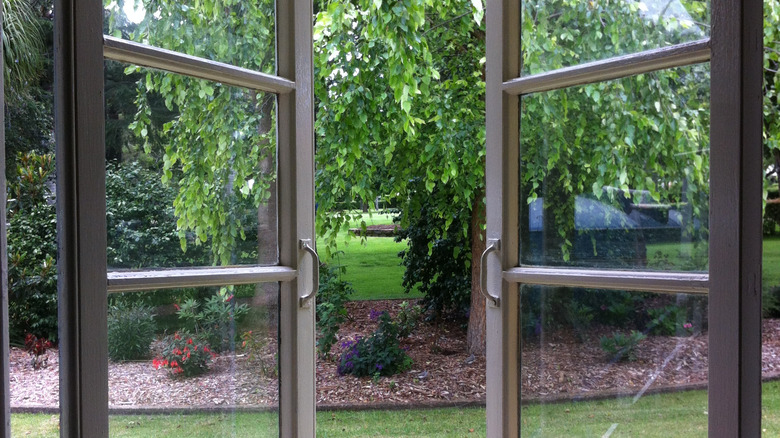What You Need To Know About Casement Windows
It's always nice to start with a little history lesson to be reminded that some things can survive trends. One of such things is casement windows, which have been well-known and sought-after for centuries. Everest and One Stop Joinery disclose that casement windows appeared for the first time in the U.K., around the 18th century, when they successfully replaced stone-mullioned windows.
One Stop Joinery states that the frames of these windows were first made of iron but later constructed of oak — this development took about a century. Britannica also lists casement windows as one of the first openable windows, detailing how this option operates like a door, opening inward or outward, made possible by the hinges installed in its vertical sash. Britannica adds that French casement windows were introduced to balconies and porches in the U.S. to spruce up the curb appeal of homes. Tag along to learn everything you need to know about casement windows!
What is a casement window exactly?
Pella describes casement windows as hinged on one side, opening easily to the left and right. They are also called crank windows because of how the handle cranks the supporting arm when flared. Adding to this, Marvin says that the sash of these windows — which is a structure inside of a window frame that holds and moves the glass pane — benefits homeowners incredibly. Compared to other window options, it allows casements to open fully, offering better ventilation and serving as an evacuation space during emergencies.
Stanek Windows names kitchens and bathrooms as standard places to install casement windows, noting how maximum ventilation is needed in those areas. Sunrooms and sitting rooms, too, but you can customize the shape to fit your aesthetic or for a dramatic effect. Pella believes that casement windows can complement any home style, whether traditional or modern. But Marvin thinks them more stylish than conventional; to make casements fit a traditional-style home, they recommend adding window grids for a simple, cleaner look.
The features of a casement window
First is the window frame, which prevents the glass pane from falling, via Everest. It consists of a sill and a head which run horizontally at the top and bottom, as well as two jambs running vertically on both sides. The sill forms the bottom part of the window frame that protects your house from rain by deflecting it. Another noteworthy part is the casement, and it's responsible for keeping the glazing in place. Then we have the mullion. TGP describes them as vertical supporting strips typically constructed from uPVC or aluminum, the same materials used for the window frame. Mullions separate various openable areas in casement windows with a fixed pane.
Lock handles are installed on jambs. Their color and style will depend on the type of casement window you choose, be it a push-out option or the crank and turn variety. Transoms, which TGP compares to mullions, are horizontal bars separating the window vents from the fixed glass panes. Trickle vents are essential for casement windows because they improve the home's ventilation and prevent condensation. Another feature of a casement window is the Georgian bars, which TGP recommends for a more traditional look. They are vertical and horizontal bars, creating smaller squares and fitted inside the window to mimic the 18th-century windows of the Georgian era.
The cost of installation and replacement
As reported by Fixr, the average price range for installing casement windows is $600 to $1,400. But the pricing varies depending on several elements such as style. A single casement window ranges from $224 to $370; French or double casement windows go for $445 to $585, and a picture window with casement flankers is priced between $600 and $800. The material also plays a factor. Vinyl comes in with a price range of $200 to $750; wood takes it up a notch at $290 to $2,000; aluminum offers a price tag of $300 to $950. The average cost of a fiberglass casement window is between $535 and $1,575, and steel is priced from $585 to $1,500.
Your preferred casement window size will definitely influence the price, too. Per Fixr, a 24 x 36-inch window costs between $262 and $354, and you will pay around $350 to $504 for the 24 x 48-inch option. A 24 x 60-inch casement window comes at about $420 to $434, while the 30 x 36-inch style has an average price between $275 and $393. When it comes to replacement, Modernize says the average price range to replace a casement window is $415 to $890.
Advantages of casement windows
Architecture Ideas names ventilation and high natural light stream as advantages of installing casement windows. This is because they open completely, unlike double-hung windows. When it comes to noise, they guarantee comfort as casement windows reduce noise levels when sealed. According to Zen Windows, casement windows give you more security since the locks are on the inside. One more advantage they mention is that casement windows are energy-efficient. They save up to 45% of energy in the winter and 70% during summer, and therefore help with saving money.
Casement windows offer low maintenance and little cleaning since they have one pane of glass. Champion mentions that casement windows provide you with a romantic spot when opened. They add that if you live in a beautiful neighborhood, you will have an unobstructed view of the outside. Champion includes the advantage of the rooms having cool temperatures since casement windows allow more air inside the house.
Disadvantages of casement windows
The way casement windows open can obstruct landscape views when installed near a deck, per Architecture Ideas. It may even be impossible to install air conditioners since these windows open outward. Architecture Ideas also points out the limitations caused by the size of casement windows. If you do not have enough space to support your preferred option, you may be unable to install it.
Champion chimes in with one more disadvantage: the lack of screens. They advise you only to buy the option with screens and recommend avoiding casement windows if you live in an area with strong winds — the intensity could damage the panes and break the window. Bell Brothers Plumbing, Heating & Air say that despite casement windows being expensive due to their hardware, you shouldn't pick cheap options which won't be secure. They mention that a casement window's security is affected by how easily the hinges become rusty. Therefore, always check the window and replace any rusty parts.
